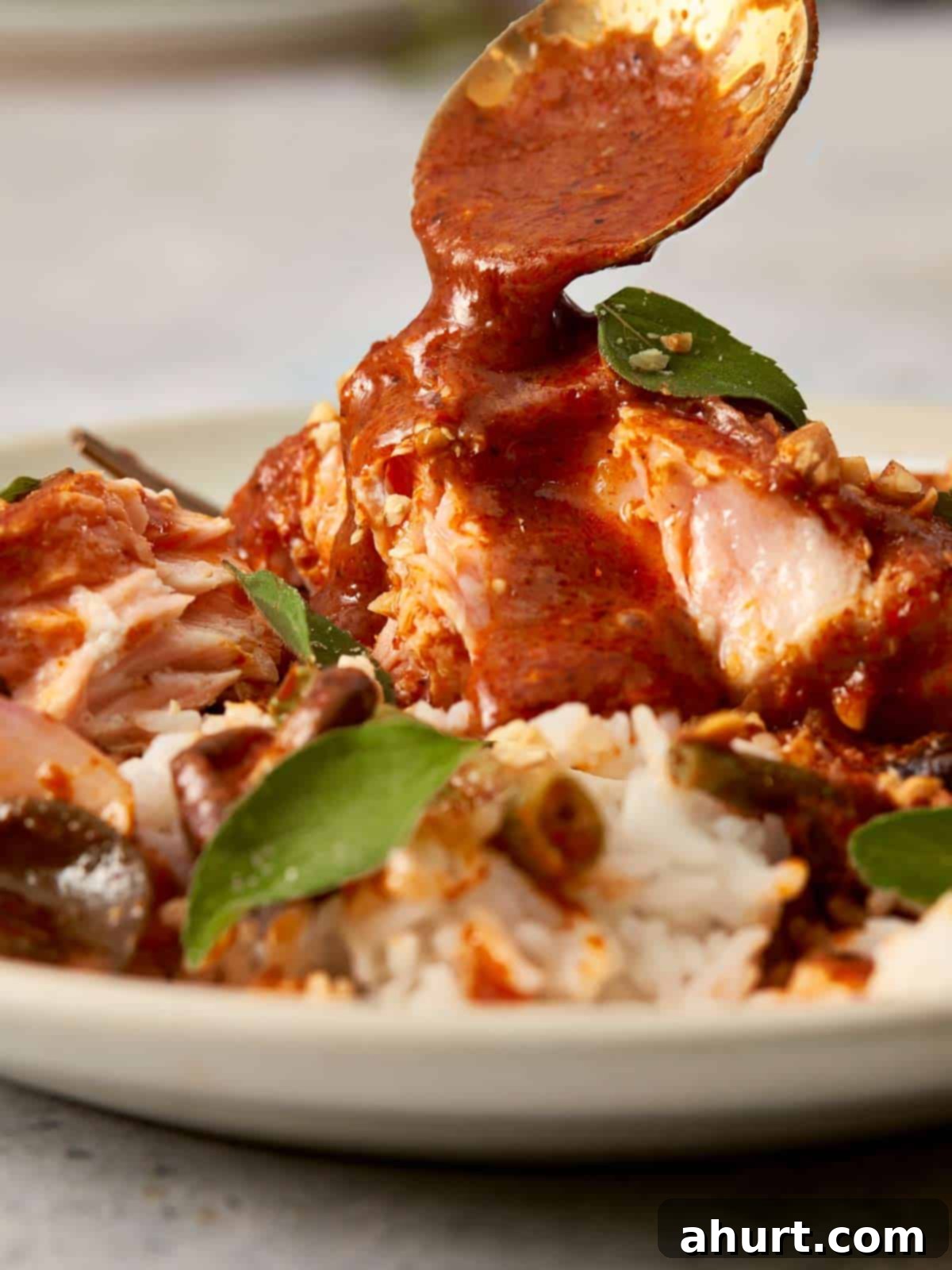Easy & Authentic Salmon Panang Curry: Creamy Thai Perfection for Weeknights
There’s an undeniable magic to a perfectly crafted Thai curry, and this Salmon Panang Curry stands out as a true masterpiece. Imagine tender, flaky salmon fillets enveloped in a rich, velvety coconut sauce, infused with the vibrant aroma of kaffir lime and the subtle warmth of Thai basil. This recipe isn’t just a meal; it’s an experience – a luxurious weeknight escape that brings the authentic flavors of Thailand right into your kitchen. It’s designed to be effortlessly chic, making your home smell like pure culinary bliss without the fuss of a complicated dinner. Whether you’re a seasoned chef or a beginner in Thai cuisine, this easy Panang curry recipe promises a restaurant-quality dish that’s both comforting and undeniably sophisticated, perfect for anyone seeking a flavorful and hearty meal.
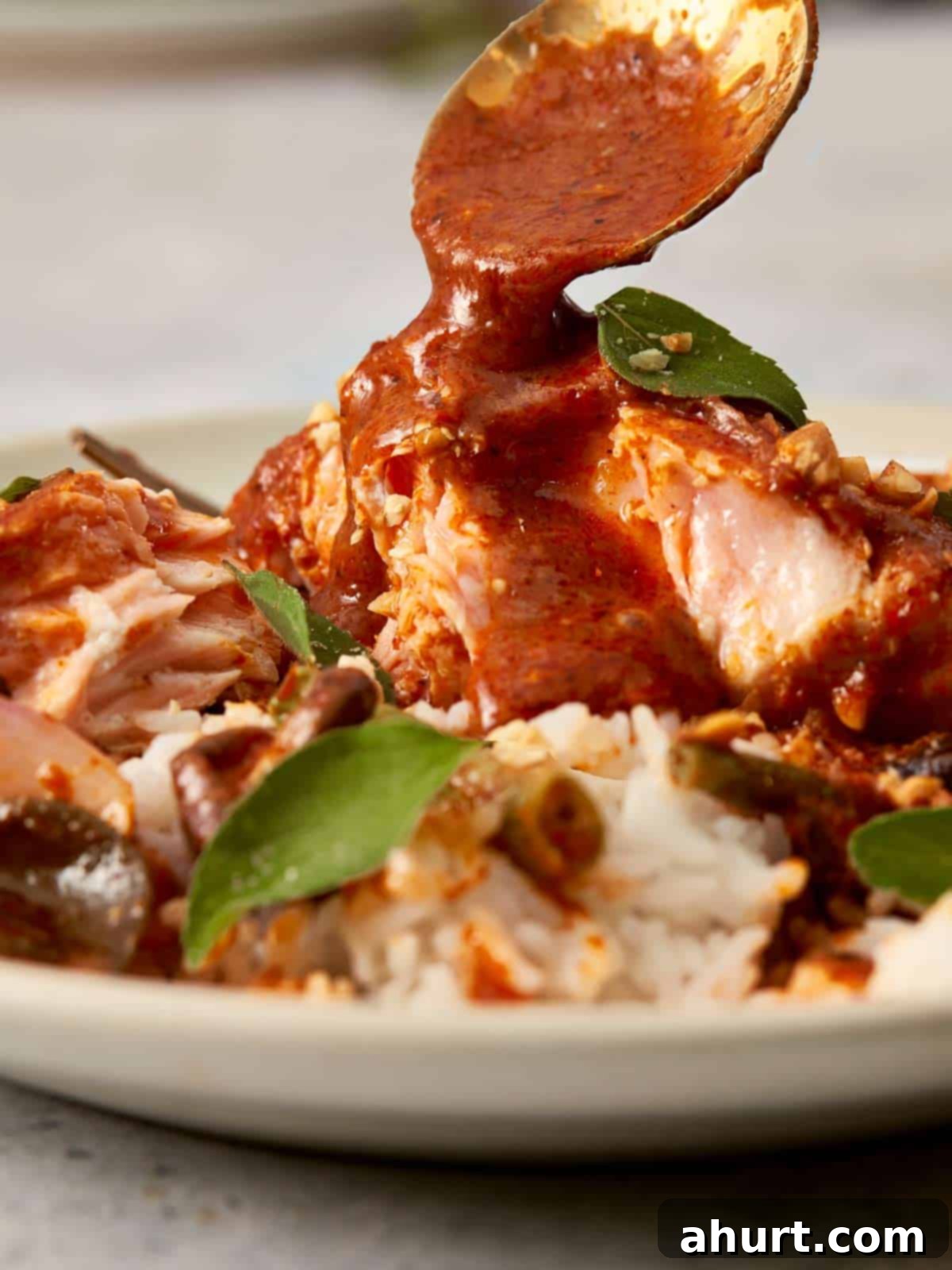
Unlocking the Authentic Flavor: What Makes Panang Curry Unique?
If you’ve ever explored the vibrant world of Thai curries, you know each variety offers its own distinct charm. While my Thai Red Curry with Chicken is a perennial favorite for its bold, fiery character, and my Garlic Butter Salmon delivers classic comfort, this Salmon Panang Curry elevates the weeknight meal to an entirely new level. It’s more than just a dish; it’s a culinary journey that celebrates rich, complex Thai flavors.
What truly sets Panang curry apart from its cousins, like the more liquid red or green curries, is its signature thick, incredibly rich, and subtly sweeter profile. Unlike the often soupy consistency of other Thai curries, Panang sauce beautifully clings to every piece of salmon, offering an intensely indulgent texture with each bite. This velvety mouthfeel is a hallmark of authentic Panang. The “secret” to its irresistible appeal lies in the meticulous balance of flavors: the delicate, caramelized sweetness of palm sugar, the bright and intoxicating fragrance of kaffir lime, and a gentle, nuanced chili heat that tantalizes your palate without overwhelming it. This harmonious blend creates a deeply satisfying and aromatic experience that leaves you craving just one more spoonful.
The name “Panang” is widely believed to originate from the Thai word “Penang,” possibly referencing the Malaysian island of Penang, or perhaps from the traditional method of preparing it with peanuts. This historical influence subtly contributes to its distinct nutty undertones, a subtle depth not always found in other popular Thai curries. This particular Salmon Panang Curry recipe achieves a wonderfully luxurious feel without being heavy, making it an ideal choice for a comforting yet sophisticated dinner. It’s remarkably fast to prepare, incredibly flavorful, and truly tastes like something you’d savor in an upscale Thai restaurant – all from the comfort and convenience of your own home. It’s a testament to how simple, quality ingredients can be transformed into an extraordinary meal.
Essential Ingredients for Your Perfect Panang Curry
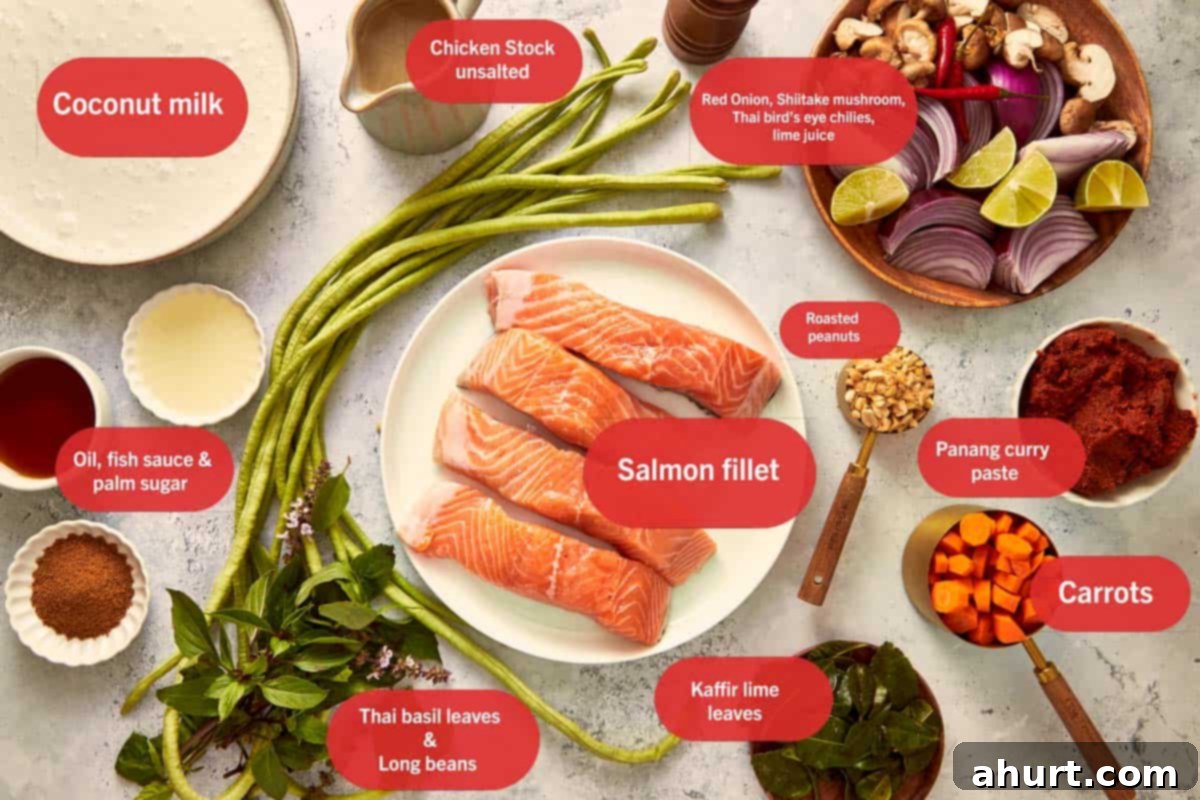
Crafting this rich, layered Thai Panang curry is all about selecting the right components and understanding how they contribute to that perfect symphony of sweet, salty, and spicy. These thoughtfully chosen ingredients are the heroes doing all the heavy lifting to deliver an unforgettable, authentic flavor experience:
- Panang Curry Paste: This potent, aromatic paste is the indispensable heart and soul of your curry. Authentic Panang paste brings a deep, complex flavor profile that is uniquely nutty, delicately sweet, and possesses a distinct yet manageable heat. To achieve the most authentic taste, look for a high-quality brand like Mae Ploy. It forms the essential foundation upon which all other vibrant Thai flavors are built, awakening your senses with its exquisite blend of spices.
- Full-Fat Coconut Milk: Absolutely essential for achieving that signature creamy, silky texture that defines a truly great Panang curry. Full-fat coconut milk provides the unparalleled richness and velvety body that lighter versions simply cannot replicate. It beautifully softens the inherent spice of the curry paste and creates a luxurious sauce that coats every ingredient, ensuring a mouthwatering experience. Do not compromise on this for the very best results!
- Palm Sugar: Far more than just a simple sweetener, palm sugar adds a nuanced, complex caramel-like sweetness and contributes significantly to the glossy, appetizing finish of the sauce. It is utterly crucial for balancing the savory, spicy, and tangy elements, creating that characteristic harmonious flavor profile unique to Thai cuisine. If palm sugar is unavailable, light brown sugar can be used as a substitute, although the final flavor will be slightly less authentic.
- Kaffir Lime Leaves: These intensely fragrant leaves are an absolute non-negotiable for achieving authentic Thai flavor. They generously infuse the curry with bright, citrusy, and subtly floral notes that expertly cut through the richness of the coconut milk, elevating the entire dish to a new aromatic dimension. Remember to bruise them slightly before adding them to the sauce to fully release their potent, captivating aroma.
- Fresh Salmon Fillets: The magnificent star protein of this exquisite dish. For optimal flavor and a beautiful presentation, choose skin-on salmon fillets. Salmon’s naturally rich, buttery texture and mild, versatile flavor make it an incredibly perfect canvas for soaking up the vibrant, complex Panang sauce, resulting in unbelievably tender, succulent bites.
- Fish Sauce (Nam Pla): This umami powerhouse is an absolute cornerstone of authentic Thai cuisine. It adds a deep, intensely savory, and perfectly salty dimension that expertly rounds out the flavors and ties every single component together. A good quality fish sauce is key to providing that unmistakable Southeast Asian depth and complexity.
- Thai Bird’s Eye Chilies: For those who delight in a bit more fiery kick! These deceptively tiny chilies pack a powerful punch, allowing you to meticulously customize the heat level of your curry to your exact preference. Slice them thinly or crush them for a more intense spice. Adjust the quantity to achieve your personal desired level, from a gentle warmth to an exhilarating blaze.
- Fresh Vegetables: The inclusion of long beans, carrots, vibrant red onion, and earthy shiitake mushrooms adds delightful texture, beautiful color, and a wholesome dimension to the curry. These vegetables are chosen for their ability to absorb the rich curry flavors beautifully while maintaining a satisfying, crisp-tender crunch. Feel free to customize with other quick-cooking vegetables like colorful bell peppers or tender broccoli florets.
- Fresh Thai Basil: Added strategically at the very end of the cooking process, fresh Thai basil provides a refreshing, slightly anise-like aroma and instantly brightens the entire curry. Its distinct and complex flavor is absolutely integral to the authentic Thai experience and, if possible, should not be substituted with common European basil.
- Roasted Peanuts: A classic and essential garnish for Panang curry. Chopped roasted peanuts provide a delightful crunch, a pleasant textural contrast, and a complementary nutty counterpoint to the creamy, smooth sauce, enhancing the overall sensory experience.
Note: Find the full, comprehensive list of ingredients, precise quantities, and detailed measurements in the complete Recipe Card conveniently located below.
Mastering Your Homemade Salmon Panang Curry: A Step-by-Step Guide
Don’t be intimidated by the rich, complex flavors of this dish; once your ingredients are meticulously prepped, this incredible Salmon Panang Curry comes together surprisingly quickly and easily, predominantly in one single pan. It’s a remarkably straightforward process that yields maximum flavor with minimal fuss. Here’s your detailed guide on how to create this creamy, fragrant, and utterly delicious Thai masterpiece that will impress everyone at your table:
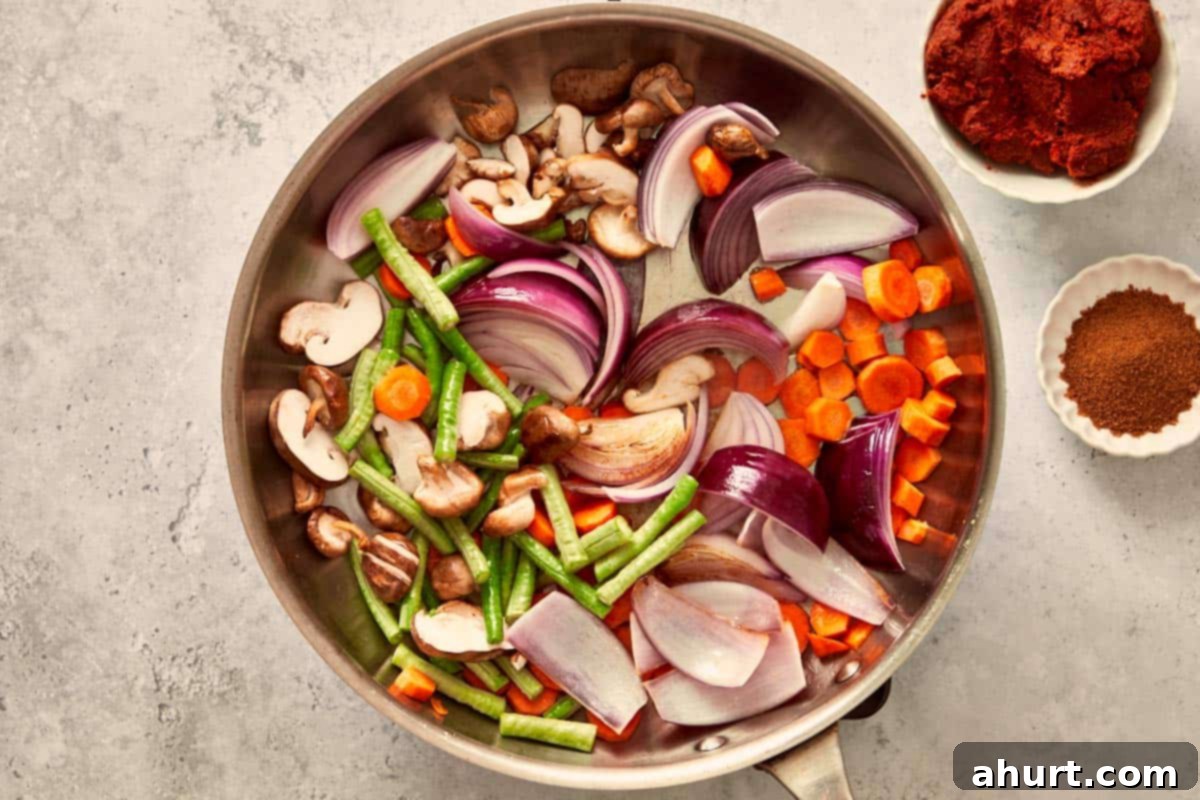
- Sear the Vegetables to Perfection.
Begin by heating a tablespoon of your preferred high-heat cooking oil in a large skillet or wok over medium-high heat. Once shimmering, add your meticulously prepared long beans, thinly sliced carrots, vibrant red onion wedges, and sliced shiitake mushrooms. Stir-fry these vegetables vigorously for about 2-3 minutes, just until they start to tenderize and develop a slight char, while still retaining a delightful crispness. This brief but crucial searing step helps to build foundational flavor and ensures they don’t become overly soft or mushy in the simmering curry. Once perfectly seared, promptly remove them from the pan and set them aside. They will be added back later to preserve their ideal texture.
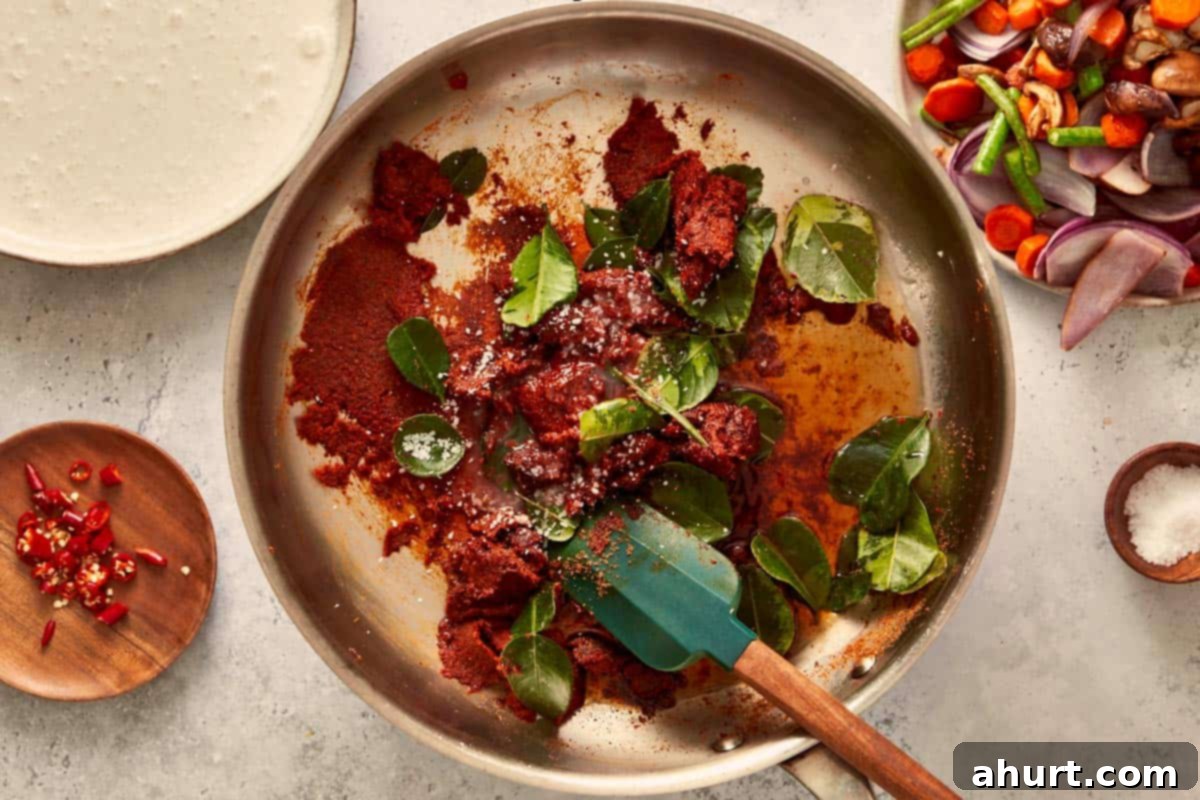
- Awaken the Curry Paste and Sweeten.
Using the exact same pan (there’s no need for additional cleaning, which saves time and effort!), reduce the heat to a steady medium. Add the entire amount of Panang curry paste to the residual oil and stir-fry it gently yet consistently for about 30-60 seconds. This crucial step meticulously “fries” the paste, liberating its complex aromatics and profoundly deepening its entire flavor profile. You will immediately notice your kitchen filling with an absolutely incredible, authentic Thai fragrance. Immediately add the palm sugar and stir constantly until it completely melts and fully incorporates into the paste, creating a deeply fragrant, slightly sticky base. This ensures the sugar dissolves completely and evenly distributes its signature sweetness throughout the foundation of your curry.
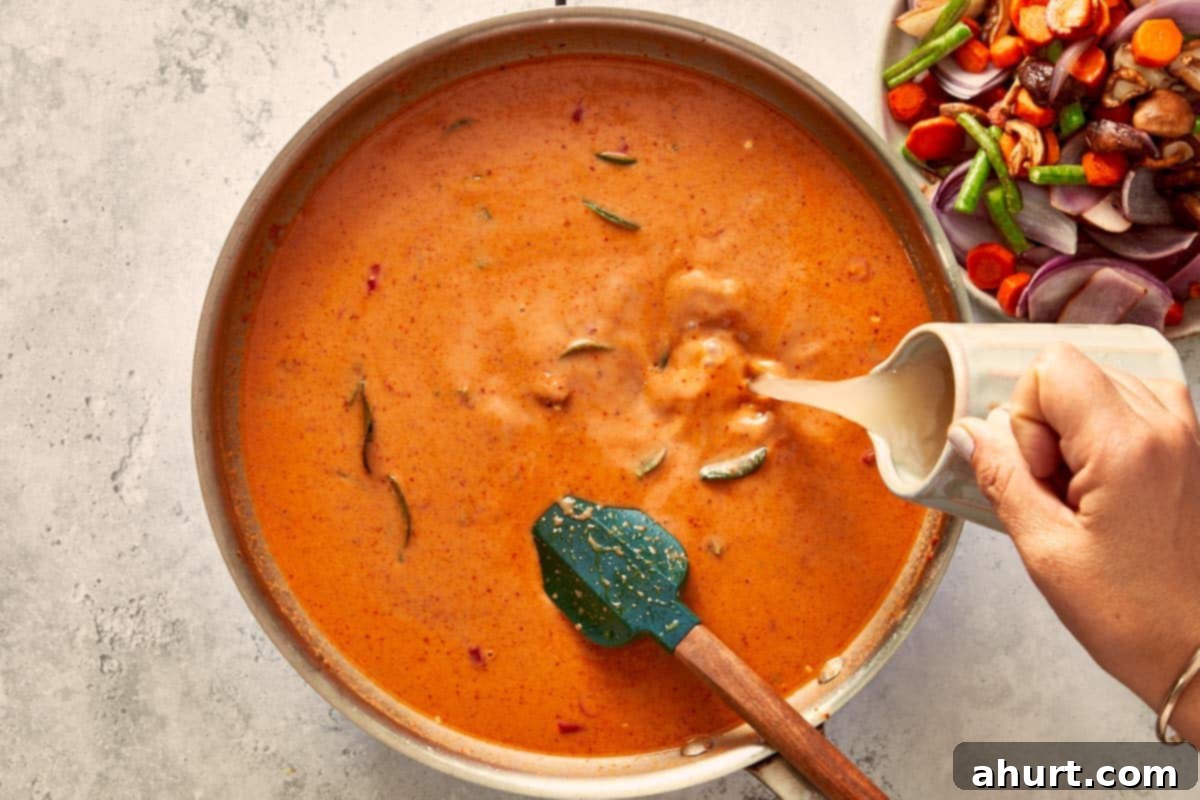
- Craft the Luxurious Panang Sauce.
Carefully pour in the full-fat coconut milk, the essential fish sauce, fresh lime juice, the torn kaffir lime leaves, and the chopped Thai bird’s eye chilies (if you choose to use them for extra heat). Stir everything thoroughly to combine, ensuring the curry paste is fully dissolved and integrated into the liquid. Bring the entire mixture to a gentle simmer over medium heat. Cover the pan with a lid and let it simmer undisturbed for about 5-7 minutes. This allows all the rich flavors to meld and deepen, and the sauce to thicken slightly to that signature, luscious Panang consistency. After simmering, stir in the unsalted chicken stock (or vegetable stock for a delightful pescatarian option) to achieve the perfect sauce consistency and add yet another layer of savory depth. At this point, it is recommended to taste and adjust the salt and sweetness if needed, ensuring perfect balance.
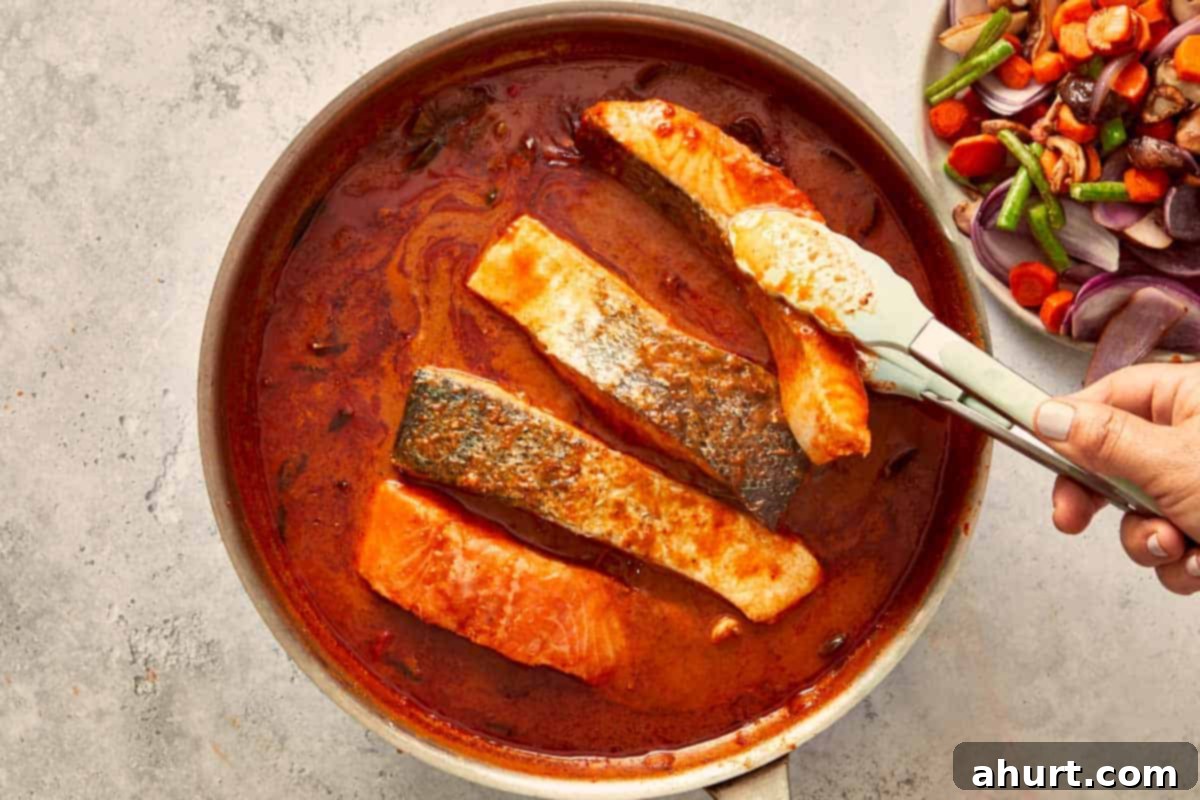
- Gently Poach the Salmon.
With utmost care, lay the salmon fillets into the gently simmering Panang sauce, skin-side down. The gentle, consistent heat of the curry will delicately poach the fish, keeping it incredibly tender, moist, and infused with flavor. Simmer the salmon for 4-5 minutes, allowing it to cook almost all the way through. The precise cooking time will vary slightly depending on the exact thickness of your fillets. Then, very gently flip each fillet once to ensure both sides are luxuriantly coated in the rich sauce and continue to cook for another 3-4 minutes, or until the salmon is just opaque throughout and flakes easily with a fork. It is crucial to be careful not to overcook, as salmon can quickly become dry if left on the heat too long.
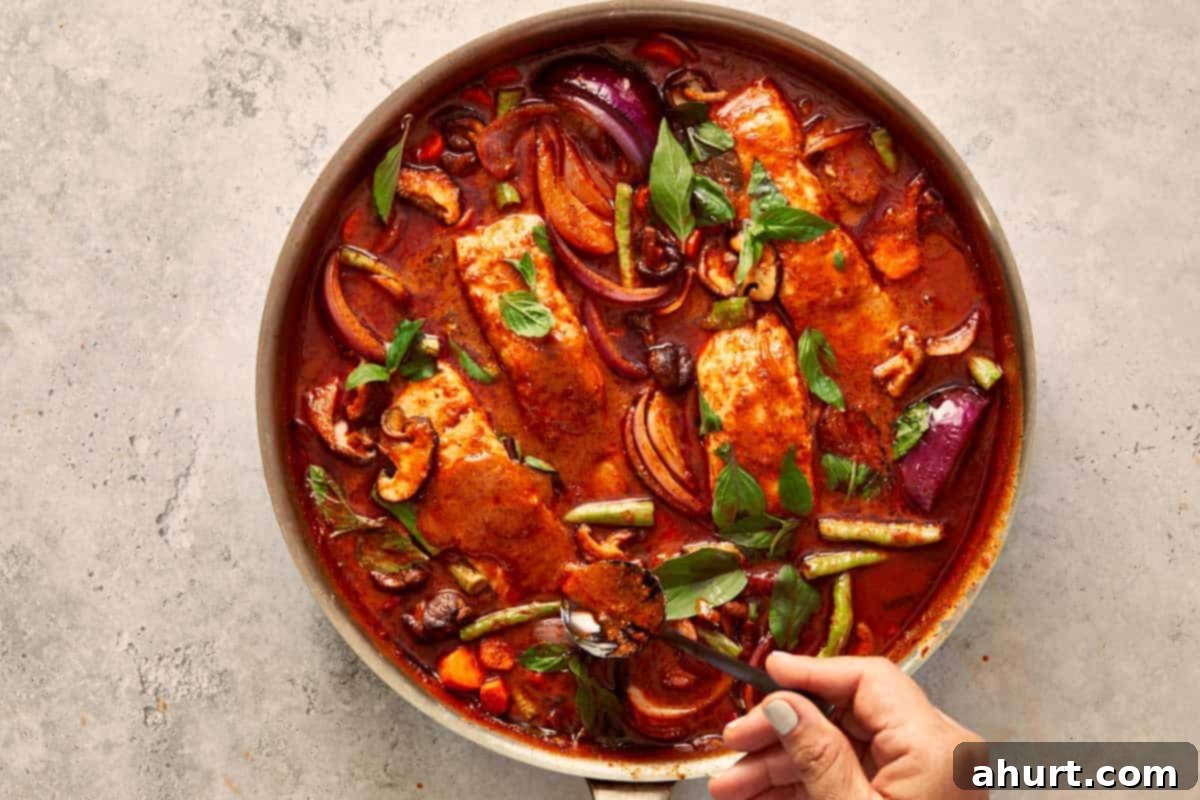
- Integrate Veggies and Fresh Basil.
Once the salmon is perfectly cooked, gently return the previously seared vegetables to the pan, carefully nestling them around the salmon fillets. Stir in the generous handful of fresh Thai basil leaves. The residual heat from the curry will swiftly wilt the basil, releasing its wonderfully aromatic oils and infusing the entire dish with its distinctive, slightly peppery, anise-like flavor. Stir everything gently to combine until the sauce looks beautifully glossy and the basil becomes wonderfully fragrant. At this critical stage, it’s imperative to taste the curry and make any final adjustments to the seasoning. You might desire a touch more fish sauce for savory depth, a fresh squeeze of lime for brightness, or a pinch of palm sugar for enhanced sweetness until it hits that exquisite, perfectly harmonious Thai balance.
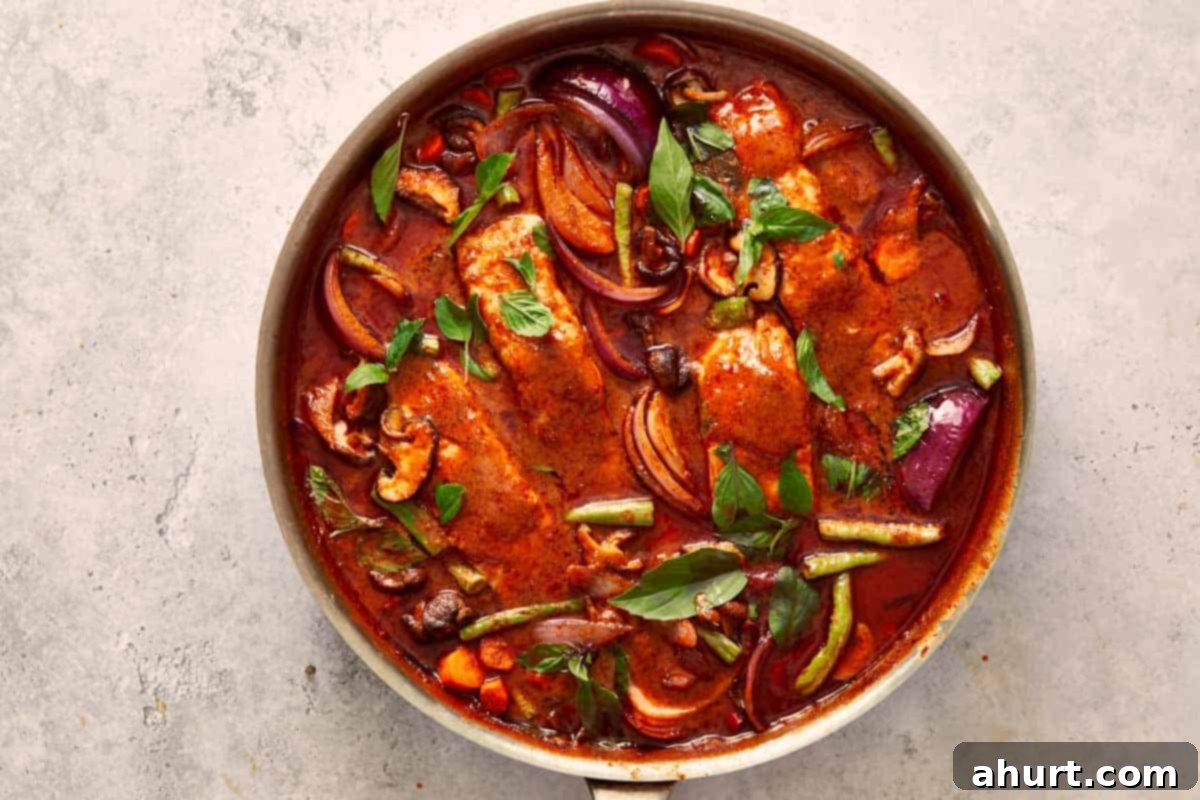
- Serve and Garnish for the Ultimate Experience.
Your magnificent Salmon Panang Curry is now ready to be savored! Serve it immediately, spooning generous portions over a mound of fluffy jasmine rice. The fragrant, slightly sticky rice is the absolutely perfect canvas to absorb all the exquisite flavors of the creamy Panang sauce. For the ultimate finishing touch, sprinkle generously with crunchy chopped roasted peanuts for added texture and a delightful nutty contrast, and scatter a few extra fresh Thai basil leaves for a final burst of aroma and stunning visual appeal. Enjoy this culinary masterpiece with delight!
To truly appreciate the artistry and execution of this dish, consider watching the full preparation in action. You can find a comprehensive video guide in the See It In Action section, offering a visual, step-by-step walkthrough to ensure your success in the kitchen and help you master every technique.
This Panang curry is a celebration of ultimate comfort — creamy, richly fragrant, and wonderfully indulgent — making it deserving of thoughtful pairings that perfectly complement and enhance its unique flavor profile. For the ultimate interactive dining experience, serve it with warm, pillowy Buttery Garlic Naan Bread. Its soft texture is absolutely perfect for soaking up every precious drop of that luscious sauce (trust us, you won’t want to waste a single drop!). To introduce a refreshing, crisp contrast, a light and vibrant Avocado Feta Cucumber Salad offers a cool, tangy counterpoint that beautifully balances the curry’s richness, providing a palate cleanser between bites. And for a truly sweet and satisfying ending to your Thai feast? Indulge in Mango Coconut Cheesecake Parfaits — their cool, creamy, and tropical sweetness will keep the delightful flavors of your meal lingering on a perfect, memorable note.
Frequently Asked Questions About Salmon Panang Curry
While you technically *can* use light coconut milk, it’s highly recommended to stick with full-fat coconut milk for the most authentic and satisfying results. Full-fat coconut milk is absolutely crucial for achieving that signature rich, velvety texture and deep, complex flavor that Panang curry is renowned for. Using a lighter version will unfortunately result in a thinner, less indulgent sauce that significantly lacks the desired creaminess and luxurious mouthfeel. For the best flavor and texture, the slightly extra calories are undoubtedly worth it!
Absolutely! Salmon is a fantastic choice for this curry due to its rich flavor and texture, but many other proteins work beautifully as well. Any firm white fish like cod, snapper, halibut, or barramundi are excellent choices – just be sure to adjust your cooking time accordingly, as thinner fillets will cook faster than salmon. For other protein options, boneless, skinless chicken breast or thighs cut into bite-sized pieces, succulent shrimp, or even firm tofu can be wonderfully substituted. If using chicken, you might want to sear it lightly before adding it to the sauce to ensure it cooks through evenly and develops a nice golden crust.
Yes, this curry is one of those delightful dishes that often tastes even better the next day, as the flavors have more time to meld and deepen beautifully. You can prepare the entire curry, excluding the salmon, a day in advance and store the sauce and cooked vegetables separately in the refrigerator. When you’re ready to serve, gently reheat the curry sauce on the stove, then add your fresh salmon fillets and cook until just done. Alternatively, you can cook the salmon with the curry and store the entire finished dish in an airtight container in the refrigerator for up to 2-3 days. When reheating, always do so gently on the stove over low heat, and add a splash of extra coconut milk or chicken stock to loosen the sauce if it has thickened too much overnight.
While fluffy jasmine rice is a classic and highly recommended accompaniment that perfectly complements the curry, there are several other delicious options to explore. It’s absolutely fantastic served with warm, soft naan bread or roti (which are perfect for scooping up every last drop of the rich sauce!), or over thin rice noodles or egg noodles for a different, delightful textural experience. You can even spoon it over a bed of steamed or roasted vegetables like cauliflower rice or zucchini noodles for a lighter, low-carb alternative. Some people also enjoy it with quinoa for added protein and fiber, or even simply as a rich, comforting stew on its own.
The spice level of this Salmon Panang Curry can be effortlessly customized to perfectly suit your preference. If you prefer a milder curry, begin by using a smaller amount of Panang curry paste than recommended, or omit the fresh Thai bird’s eye chilies entirely. It’s always easier to add more heat than to take it away, so you can always add a pinch of chili flakes or a tiny bit more curry paste at the very end if you find it too mild for your liking. For those who absolutely adore heat, feel free to increase the quantity of chilies (sliced or crushed) or add an extra tablespoon of curry paste. Always taste as you go to achieve your ideal level of warmth!
Yes, you can absolutely freeze leftover Panang curry! It freezes quite well, allowing you to enjoy this delicious meal at a later date. However, please note that the texture of the salmon might become slightly softer or flakier upon thawing and reheating compared to freshly cooked. To freeze, ensure the curry is completely cooled, then transfer it into an airtight, freezer-safe container. It can be stored in the freezer for up to 2-3 months. When you’re ready to enjoy it, thaw it overnight in the refrigerator and then gently reheat it on the stovetop over low heat. You might find it beneficial to add a small amount of extra coconut milk or chicken stock to help restore its original creamy consistency and loosen the sauce.
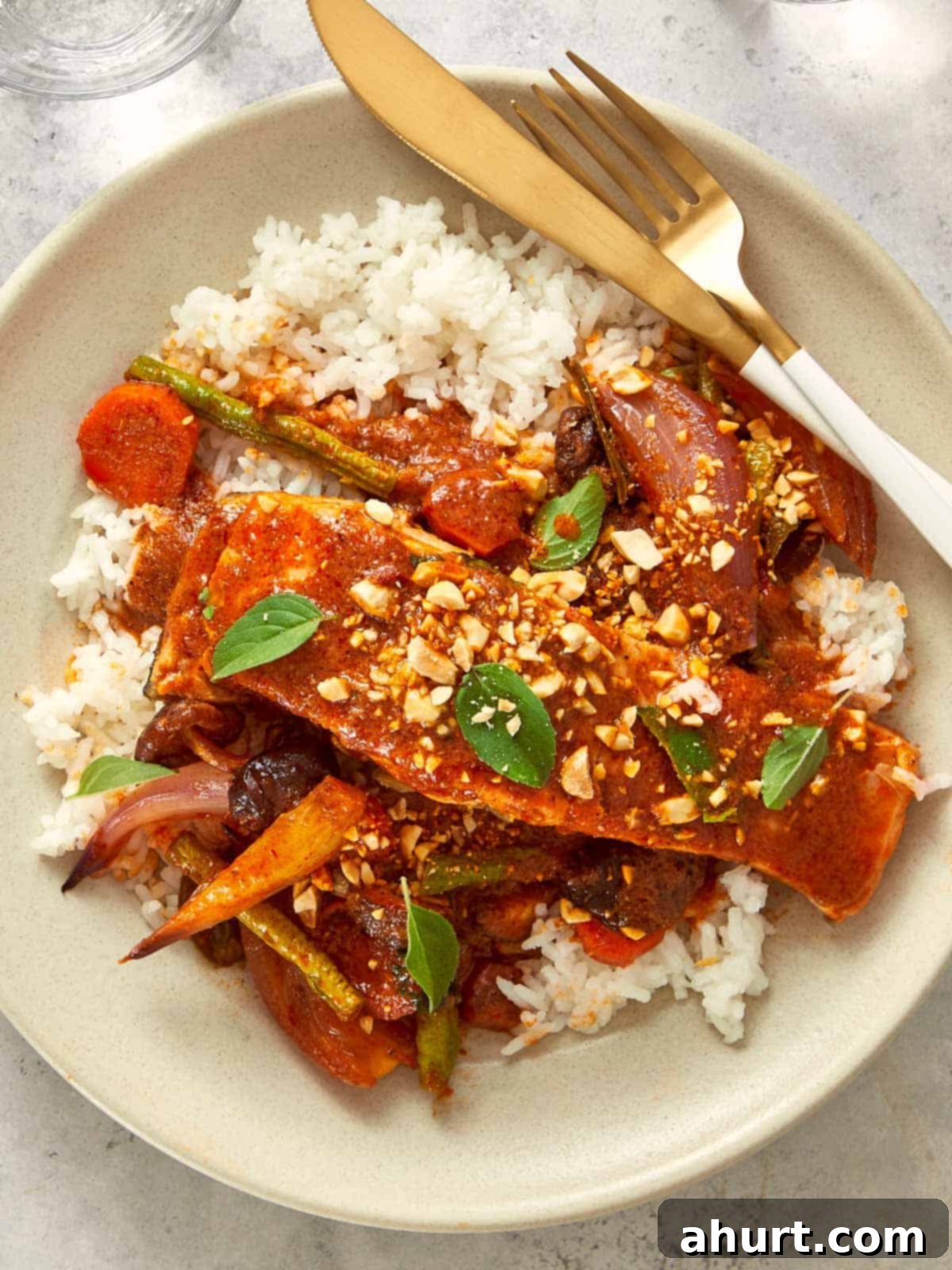
See It In Action: Step-By-Step Video Guide
Sometimes, seeing is truly believing, especially when it comes to mastering new and exciting recipes. To help you perfect every nuance and technique involved in creating this delicious Salmon Panang Curry, we’ve meticulously prepared a detailed step-by-step video guide. Watch closely as each ingredient transforms into a harmonious symphony of flavors and textures, making it incredibly easy for you to follow along and confidently replicate the magic in your very own kitchen. This comprehensive visual walkthrough is an invaluable resource to ensure your curry turns out perfectly creamy, wonderfully fragrant, and utterly delectable every single time.
After watching the video, you’ll be fully equipped with the confidence and knowledge to whip up this incredible Thai dish with ease and expertise. Don’t forget to check the detailed recipe card below for precise measurements, additional expert tips, and nutritional information to make your culinary journey a complete success!
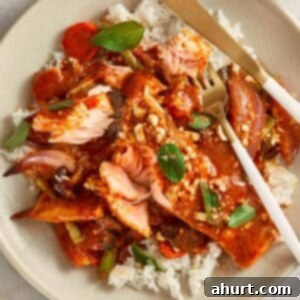
Pin
Salmon Panang Curry Recipe
Ingredients
- 1 tbsp oil for frying
- 1 cup long beans cut into 2-inch pieces
- 1 cup carrot slices 0.2-inch thick
- 1 red onion cut in wedges
- 1 cup shiitake mushrooms sliced
- 6 tbsp panang curry paste mae ploy
- 1½ tbsp palm sugar
- 8 kaffir lime leaves torn
- 3 thai bird’s eye chilies chopped
- 3 tsp fish sauce
- 3 cups coconut milk
- 1 tbsp lime juice
- ½ tsp salt
- 1½ cups unsalted chicken stock
- 24 oz salmon fillet skin on 4 fillets
- 1 cup thai basil leaves roughly torn
- ½ cup roasted peanuts chopped, for topping
- Extra thai basil leaves for garnish
Instructions
-
Heat the oil in a medium saucepan over medium-high heat. Add beans, carrots, red onion, and shiitake mushrooms. Stir-fry for 2-3 minutes until just tender-crisp. Remove from the pan and set aside.
-
In the same pan, add Panang curry paste. Stir-fry for 30-60 seconds until fragrant and aromatic. Add palm sugar and stir constantly until it melts and incorporates fully into the paste.
-
Add kaffir lime leaves, chilies (if using), fish sauce, coconut milk, lime juice, and salt. Mix well, cover with a lid, and simmer gently for 5-7 minutes until the sauce thickens slightly and flavors meld. Stir in chicken stock.
-
Gently place salmon fillets into the simmering curry sauce, skin-side down. Simmer for 4-5 minutes, then carefully flip once and cook for 3-4 minutes more, or until the salmon is just opaque and cooked through. Avoid overcooking to keep the salmon moist.
-
Return the sautéed vegetables to the pan. Add fresh Thai basil leaves and stir gently to combine everything until the basil wilts and becomes fragrant. Taste and adjust seasoning as needed (more fish sauce for salt, lime for brightness, or palm sugar for sweetness).
-
Serve hot over jasmine rice, garnished generously with chopped roasted peanuts and extra fresh Thai basil leaves for a beautiful finish. Enjoy immediately!
Notes
A few small, but significant, tweaks can truly elevate this curry, making all the difference in bringing out every exquisite layer of flavor. Follow these expert tips to ensure your homemade Panang curry is nothing short of sensational and genuinely authentic.
- Prioritize full-fat coconut milk for that luxurious, thick, and silky sauce that perfectly mimics restaurant quality. Light versions will compromise the texture and richness, resulting in a thinner curry. Opt for full-fat to achieve the ultimate creamy consistency and profound flavor depth that defines Panang curry.
- Never rush the curry paste frying step. Sautéing the Panang curry paste in a little oil for a minute or so is absolutely crucial. This process “wakes up” all the aromatic Thai spices, releasing their full, complex flavors and building the foundational depth and character of your curry. It’s truly where the magic of the dish begins to unfold.
- Manage the heat to your preference, especially if you’re new to the inherent spice levels of authentic Thai curries. Start with a conservative amount of chilies or curry paste. You can always add a pinch more chili flakes or a tiny bit more curry paste later, once you’ve tasted the sauce and precisely determined your desired level of warmth.
- Incorporate the salmon towards the very end of cooking. Salmon cooks remarkably quickly and can easily become dry and tough if overcooked. By gently poaching it directly in the simmering curry sauce during the final minutes, it stays beautifully buttery, incredibly tender, and perfectly flaky, absorbing all the rich flavors without compromising its delicate texture.
- Achieve perfect balance before serving. A truly great Thai curry is all about exquisite harmony. Always taste the sauce at the very end and adjust the seasonings meticulously. Add more fresh lime juice for a bright, tangy lift, a dash more fish sauce for savory saltiness (umami), or a bit more palm sugar for subtle sweetness until you hit that exquisite, perfectly balanced Thai flavor profile that excites your palate.
- Garnish generously with fresh basil. The vibrant, aromatic fresh Thai basil added at the very end is not just for visual appeal; it’s a critical flavor component. Its distinct taste provides a final burst of freshness that lifts the entire dish, contributing a beautiful fragrance and a vital, authentic element to the overall Thai experience.
Nutrition
Nutrition information is automatically calculated, so should only be used as an approximation. Please consult a nutritionist for personalized dietary advice.
